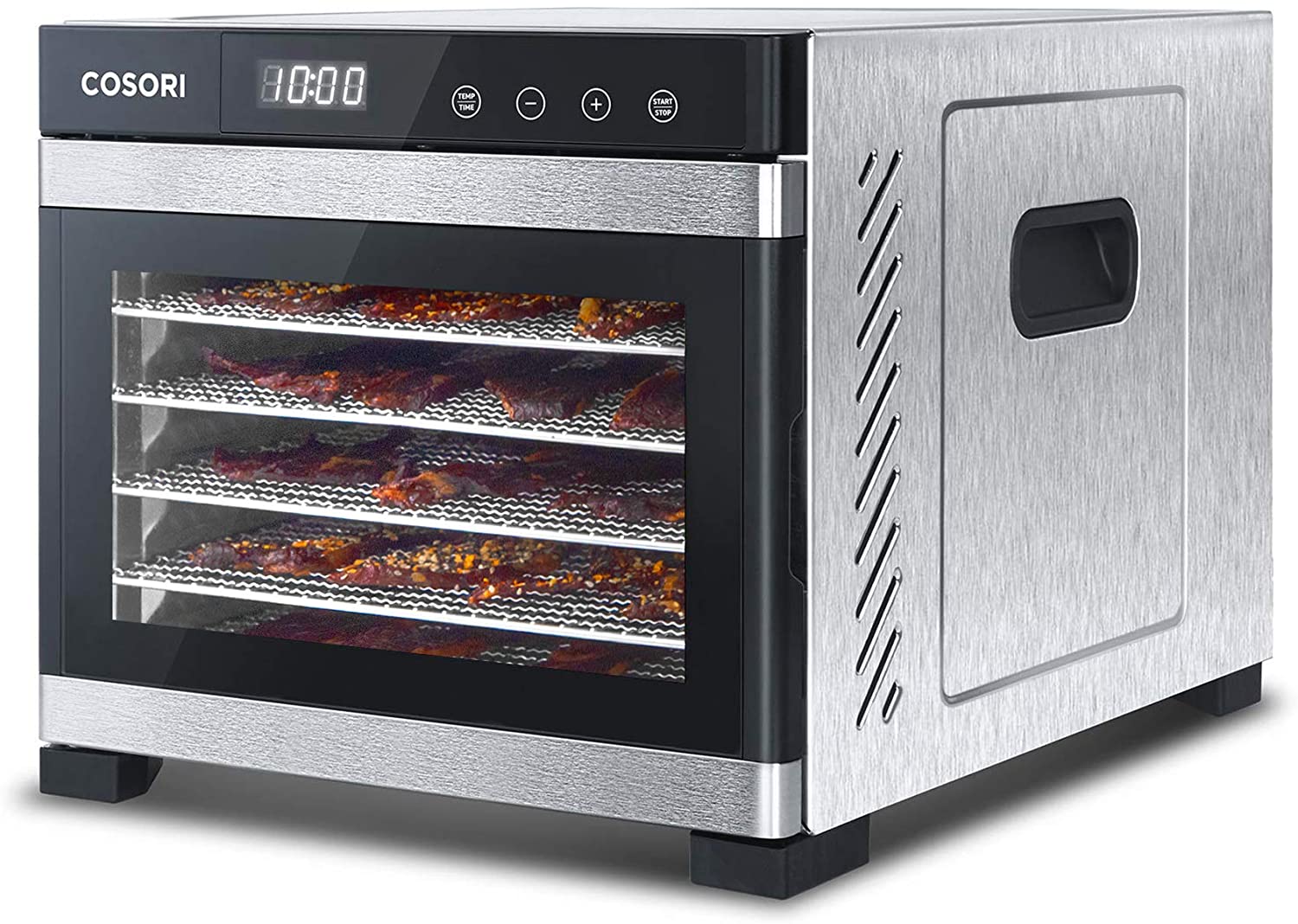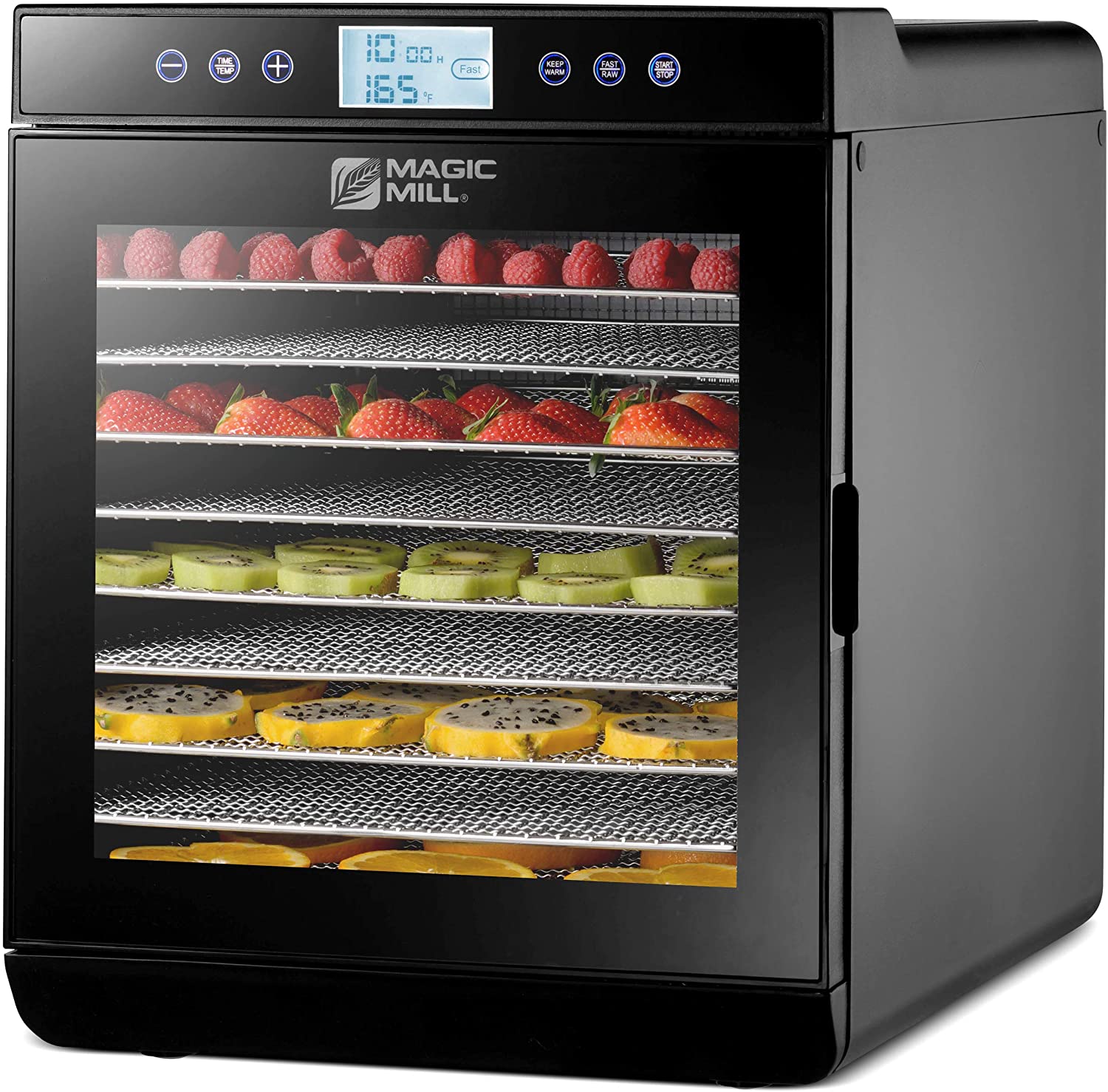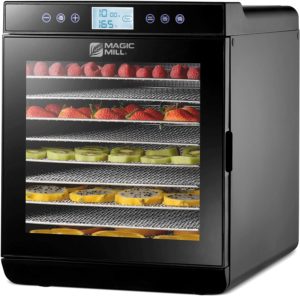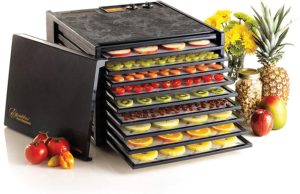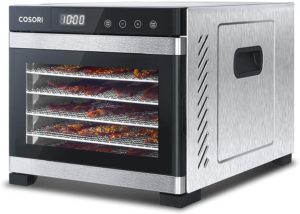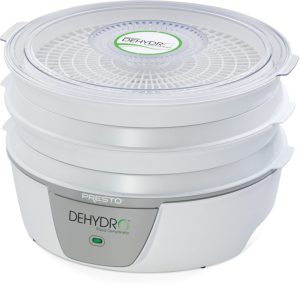It’s a sad fact, but fresh mushrooms don’t keep forever. Drying may be the simplest and most versatile way to preserve mushrooms that can’t be eaten right away.
The most basic and traditional method is simply air-drying, which requires no special equipment. Simply slice the mushrooms thinly and either spread them across a table-top or string them into garlands and hang them up. Provided the air-flow is good, most species of mushroom will dry in a few days, even in a humid climate.
But using a food dehydrator means not having to sacrifice the dinner table to drying mushrooms for a week. Depending on the design, a dehydrator can offer more control, which is important for some mushroom species. Plus, in humid conditions the traditional method might not be able to get the mushrooms quite as dry, shortening shelf-life from years to weeks. Investing in a dehydrator is a good option for people who grow magic mushrooms or simply want to preserve their edible ones longer. A good food dehydrator is as important as a good book or field guide, a good knife, and/or a good basket or collecting container.
IMAGE | PRODUCT | Header | ||
|---|---|---|---|---|
OUR #1 RATED Temperature Settings and 26-hour Timer Automatic Shut Off | ||||
6 Stainless Steel Trays w/Digital Timer and Temperature Control | ||||
Easy Setup, Digital Adjustable Timer, Temperature Control, Keep Warm Function | ||||
The Art of Dehydrating Mushrooms
Besides extending shelf-life, drying is also a way to enhance the flavor of some species, and drying is the first step to making mushroom powder—powder can be used in broths, butters, rubs, and other contexts, and is a great way to use insect-damaged mushrooms or mushrooms with texture problems, such as puff balls.
Some writers claim that dehydration can even deactivate certain toxins, just as cooking does, but it isn’t true. Dehydrators don’t get hot enough. Mushrooms that go into the dehydrator raw also come out that way.
Dried mushrooms will usually turn out OK no matter what method is used, but for best results, there’s an art to it[i].
- Clean the mushrooms properly first and remove any bugs or bad spots.
- Do not put wet mushrooms in the dehydrator. Mushrooms that were washed or rained on must be allowed to air-dry first or their shelf-life will be very short.
- Some species, and older specimens generally, react very badly to getting too warm, or not warm enough during drying, or to not getting enough air. Learn these picky species and how to baby them.
- Notice how dry the mushrooms are. Ideally, dried mushrooms become almost brittle and get stored in humidity-proof containers (they can partially re-hydrate themselves in humid air). If the ideal is not possible, that’s OK, the mushrooms will still last much longer than fresh ones, but their shelf-life will be measurable in weeks, not years. Be sure to use them quickly.
- Except for powders, which can be used dry, mushrooms must be carefully re-hydrated before use. Placing dried mushrooms in water lets the flavor leak out of the mushrooms, creating weak mushroom tea. To avoid losing flavor, use as little re-hydration liquid as possible, and add any that does not get absorbed to the cooking pan. Never let the mushrooms sit in water too long, either, unless the plan is to puree them, since extended baths make mushrooms slug-like.
What to Consider when Choosing a Dehydrator?
Unless a mushroom is “picky,” any dehydrator should give OK results. For better-than-OK results, though, the choice of equipment matters and depends on the specifics of the user’s needs (and budget)[ii].
Type
Dehydrators can be either vertical or horizontal[iii]. Either type can be made at home, but both are ALSO commercially available. Commercially available models are generally electric, but some DIY designs use solar heat only.
Vertical dehydrators consist of a stack of mesh plates or trays that air flows through vertically, either up or down, depending on where the blower is. Horizontal dehydrators consist of a box with removable mesh shelves. Airflow is horizontal across the shelves.
Vertical models tend to be more basic. Plus, plates can’t be removed individually because they rest on each other’s rims, but the stack can be made taller or shorter by adding or removing plates. The plates don’t dry at the same rate. Either move the plates around so they dry evenly or be prepared to unload some plates early.
Horizontal models tend to be fancier. Though some have stacking shelves, in most the shelves slide in and out like drawers, meaning that it’s possible to remove the middle one and leave the others in place. All shelves dry at the same rate.
Capacity
Dehydrators vary from little models able to handle only a pint or two at a time to huge industrial machines able to handle hundreds of pounds, and everything in between. Generally, it’s best to get the smallest dehydrator that is adequate for expected need, since it will be easier to store when not in use.
Control
Some dehydrators just turn on and off. They generally keep a consistent temperature, so if that temperature is the right one these machines are fine. Some trial and error might be necessary, though, to find out what that temperature is.
Users who want to tackle “picky” mushrooms, or who want to avoid the “error” part of trial and error, will want a unit with adjustable heat. Everyone else can save a few bucks and keep things simple.
Electricity Demand
Running the fan and the heating element both take electricity. Especially if the dehydrator is going to be in frequent use, it’s worth checking to see how much power it will use. The right model is the one that uses the least but still meets the user’s needs.
Ease of Cleaning and Maintenance
Even a “cheap” model should last many years with luck and proper care. Higher quality just makes bad luck less likely.
Dirty dehydrators can breed bacteria, or even break. Mushrooms don’t drip juice the way fruit or meat can, but they do release spores. Some species will release enough spores while drying to clog up the blower fan. Can the dehydrator be disassembled for cleaning? If not, its days may be numbered.
Vertical dehydrators are more likely to get clogged, especially those with their blower vents on the bottom. On the other hand, their plates can just un-stack and go through the dishwasher. There is no box to wipe down.
The Top 5 Food Dehydrators for Mushrooms
It’s possible to make a great food dehydrator at home. Plans are available online, or users can design something that fits their needs perfectly. But for those who aren’t handy, or who are in a hurry, there are plenty of options available commercially. Here are five popular examples.
Magic Mill Food Dehydrator
This handsome, black, horizontal dehydrator has adjustable heat, and automatic shut-off with a timer, and a window to make monitoring the process easy. Capacity is large, for an at-home unit, and drying time is fast. Besides the stainless steel wire trays, there are mesh fruit trays, sheets for fruit leather, and a rack for hanging items. A good option for the pickiest mushrooms and able to handle large hauls quickly. Plastic accessories and housing may bother some, and this is the priciest model of the five.
Buy the Magic Mill Food Dehydrator Here.
Excalibur 9-Tray Electric Food Dehydrator
Excalibur’s horizontal drier hovers at a price point similar to the Magic Mill and machine is almost as large, but it does not have as many bells and whistles (adjustable heat yes, but no timer). The plastic construction and the noisy operation bother some. However, dehydration is very fast, the capacity is impressive, and the unit is very easy to clean.
Buy the Excalibur 9-Tray Electric Food Dehydrator Here.
COSORI Premium Food Dehydrator
Another sleek horizontal dehydrator, this one in silver and mid-size (somewhat like a large toaster oven). Adjustable heat, automatic shut-off with timer, and notably quiet operation—it could run in a library and not bother anyone. Comes with stainless steel trays, a mesh screen for fruit (or small mushrooms), a fruit leather sheet, and a recipe book. The large window makes monitoring progress easy. Some users are frustrated by the lack of extra trays and other accessories, but it is easy to clean.
Buy the COSORI Premium Food Dehydrator Here.
Nesco Snackmaster Pro
At a much more moderate price, the lack of bells and whistles in this model makes good sense. It is a horizontal drier, but the trays stack. It lacks a timer, and while the heat is adjustable, some users report variation. The capacity can be more than doubled through the addition of extra trays, and the machine is surprisingly light-weight. The top-mounted fan makes clogging less of a concern. Comes with a range of useful accessories and a seasoning packet.
Buy the Nesco Snackmaster Pro Here.
Presto 06300 Dehydrator
This machine is a fraction of the cost of the others on our list and is simple but very functional. It does not have adjustable settings, although the fixed heat setting should be high enough to safely prepare jerky. Its capacity can be doubled by the addition of more stacking trays, and the trays and lid are dishwasher-safe. A variety of additional accessories, including a jerky spice kit, are available, and the compact, lightweight body is easy to move and to store. It’s a good option for someone drying a couple of pints of non-picky mushrooms a few times a year, and who doesn’t want an extra major appliance taking up space in the meantime.
Buy the Presto 06300 Dehydrator Here.
References:
[i] Bergo, A. (n.d.). How to Dry or Dehydrate Wild Mushrooms.
[ii] Rust, D. (n.d.). Purchasing and Using a Mushroom Dehydrator. Bay Area Mycologicial Society: The Art and Science of Mushrooms
[iii] Schultz, P. (2019). 9 Best Electric Food Dehydrators for Mushrooms/Fruit/Nuts.



